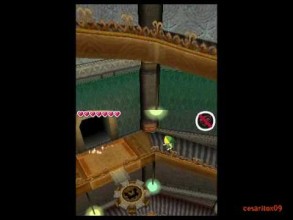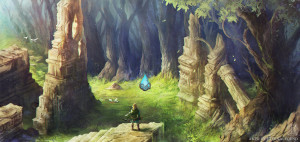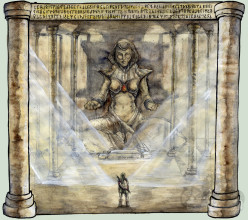What Makes a Dungeon a Dungeon?
Posted on February 21 2016 by Jon Lett

I don’t think any real Zelda fan would say that a dungeon is a dungeon is a dungeon, right? When you walk into a dungeon, you know that’s what it is, but they are always different, in every new game. How do we know, though? When you think about it, beyond a short sweeping intro shot, or a visible title, there is little that definitively indicates that you are in one of Zelda’s staple dungeons. Sure, you almost always end up finding a new item or two, and there will likely be a boss waiting for you, but what about the smaller details? Is it the architecture? The puzzles and traps? The monsters fight? Personally, I think there are some subtle aspects that are much more worth noting – aspects that are perhaps even worth deviating from. Is there a certain constant feature of these places that you always see, but have never really thought about, and what kinds of innovative styles for new dungeons could be born from defying the conventions of past games?
I may have a few ideas. Hit the jump for my thoughts on the matter.
 I think that the most obvious conclusion one may come to is that a dungeon is some dank place where you solve puzzles to make your way around – eventually coming to find new items to use and new monsters to fight. Some will likely even say that said areas must always be indoors, and enclosed through its architecture. I disagree. Please refer to this quote from the VERY early days of Zelda Wii U’s development, from a so-called “source” talking about the game to Wii U Daily:
I think that the most obvious conclusion one may come to is that a dungeon is some dank place where you solve puzzles to make your way around – eventually coming to find new items to use and new monsters to fight. Some will likely even say that said areas must always be indoors, and enclosed through its architecture. I disagree. Please refer to this quote from the VERY early days of Zelda Wii U’s development, from a so-called “source” talking about the game to Wii U Daily:
“The first test dungeon they made was a giant forest running on early and buggy Wii U hardware — the dungeon was bigger than the Hyrule field in Ocarina, and the whole thing is one dungeon. You use the gamepad to navigate, avoid traps, follow clues etc. It’s dark, lush, with a ton of trees, foliage, some which you have to cut your way through. Its scope and details are unlike anything you’ve seen in a Zelda game”
Now, this is basically guaranteed to be a fake set of information at this point, coming from an unconfirmed Japanese source, but that’s not really the point. At the time, it was the concept that wow’d me. When I first read that quote back then, I was elated. This sounded incredible, and I hoped that they went with this kind of innovation and creativity for all the new dungeons. Thinking about it, a forest with select areas of clearings, tight-knit trees on all sides, and a mostly closed-up forest canopy can feel almost like you are indoors. Such a place almost sounds like the areas before certain series dungeons. Think of Skyward Sword‘s Faron Woods, only with a darker atmosphere and more puzzles to solve. The woods already have you moving in a rather linear path, and you need to work through certain small actions along the way to finally get to the first dungeon. A better example is A Link to the Past‘s Skull Woods, which has you regularly returning to an outdoor area of the surrounding forest, with little light, and a maze-like layout. When thinking of what connects these places and the dungeons that follow them, I can help but notice the sense of claustrophobia one could feel were the environment tweaked slightly. And I think that is the big requirement here: confinement.
Imagine a huge, dense forest, where you feel confined to where you are, unable to escape through the thick layers of trees, with only subtle light falling in through the canopy, barely lighting the area. That light falling into our hypothetical forest gives you hope of escaping outside, but the very environment keeps you aware of your need to make your way out. Plus, I could even imagine such a place getting darker as you go, perhaps turning to night overtime, making it feel even more dangerous. Many of the series’ past dungeons make a point of creating that same aura of danger and discomfort as you make your way through each room, and some have even trapped you in smaller areas, forcing you to solve puzzles and beat monsters to escape. That “confinement” is a very effective design feature, and one that I’d say is a staple in many existing dungeons despite the occasional outdoor areas, like Forsaken Fortress’ patrolled outer platforms, Dragon Roost Cavern’s highly narrow cliff sides, or the City in the Sky’s confinement to it’s bridges and platforms. Forcing players into feeling trapped like that is well-worth exploring further in future dungeons, especially if they get really creative with it. One major thing I think we can all agree on is dungeons’ near-constant lack of a friendly presence. Now, that may or may not mean that you actually meet anyone. After all, no FRIENDLY presence does not mean you are alone, but I will get to that. Unless you are playing a title with a constantly following partner, you will be hard pressed to find other non-dangerous characters to talk to along the way. The only major exception I could think of is the Goron Mines, which had the Goron elders, but they were in “rest spots” of sorts, that even had different music, to separate them from the rest of the dungeon’s dangerous-feeling rooms. The City in the Sky’s Oocca were all over the place, but were never even spoken to. They acted as intelligent characters in the game’s story, but were basically used as tools in the puzzles. Other than that, the developers seem to want to emphasize the loneliness easily associated with the dungeons. But who says loneliness, as a concept, is so cut and dry? There are some very effective ways to surround a player with other characters, and have them feel like the only one in the room. It all depends on who is around.
One major thing I think we can all agree on is dungeons’ near-constant lack of a friendly presence. Now, that may or may not mean that you actually meet anyone. After all, no FRIENDLY presence does not mean you are alone, but I will get to that. Unless you are playing a title with a constantly following partner, you will be hard pressed to find other non-dangerous characters to talk to along the way. The only major exception I could think of is the Goron Mines, which had the Goron elders, but they were in “rest spots” of sorts, that even had different music, to separate them from the rest of the dungeon’s dangerous-feeling rooms. The City in the Sky’s Oocca were all over the place, but were never even spoken to. They acted as intelligent characters in the game’s story, but were basically used as tools in the puzzles. Other than that, the developers seem to want to emphasize the loneliness easily associated with the dungeons. But who says loneliness, as a concept, is so cut and dry? There are some very effective ways to surround a player with other characters, and have them feel like the only one in the room. It all depends on who is around.
It’s interesting. That same Wii U Daily article brings up some powerful dungeon concepts. Fake or not, one can’t help but think deeply on the points brought up about design, scale, and complexity of Zelda Wii U’s possible dungeons. In fact, one segment brings up not only their size, but also their layout, being broken up into separate parts:“Hssss! The Reaplings should’ve scared the life from this boy in the hold… Doesn’t he know he’s supposed to play along in this little game?” “Teehee! All it means is we’re going to have to play rough!”
“Awwwww, did you come here to save Tetra, little man? Teehee! Oh, no, no! Instead, we’ll play with you the same way we played with her!”
– Cubus Sisters, Phantom Hourglass
“[Zelda Wii U will have] about the same amount of dungeons as previous Zelda games, but these will be vastly bigger in scope and will be totally different from each other. Some dungeons are so big they’re broken up in 3 parts and will literally take hours to complete.”
It is my firm belief that a good dungeon could easily involve multiple visits over the course of the game. Given the right size of the whole complex, and some real shifts in difficulty and design, I could imagine coming back to a dungeon two, maybe three times, and still enjoying it thoroughly. Just because you find an item and kill a boss, that should not warrant never visiting the place again. Now, there are right and wrong ways to do this. I am more than happy to say that the Temple of the Ocean King is the wrong way to do it. Going through the exact same areas four or five times in a row is not fun. It’s repetitive. Now, the Tower of Spirits was better. Though the style remained the same, the puzzles, difficulty and content grew every time you came to a new floor. I appreciated that, and I believe another dungeon should take on such a method every now and then. Even a dungeon like the Spirit Temple would be welcome – only a small section is explored first, and then your second visit involves those same areas, but you are older and more equipped, allowing better access to those rooms, and many other new ones.
 This revisiting idea could work especially well for dungeons that are, for lack of a better term, “theme-less”. Obviously Zelda has a number of themes for certain dungeons – fire, water, forest, etc. – but some of my favorites are the ones without assigned themes, like Sky Keep, the Palace of the Four Sword, and various Hyrule Castles. I could imagine incorporating some themes into newly discovered sections of revisited dungeons could very much help the value of return trips. There really ought to be more dungeons like that, if only for the sake of not forgetting about a dungeon the moment you clear it.
This revisiting idea could work especially well for dungeons that are, for lack of a better term, “theme-less”. Obviously Zelda has a number of themes for certain dungeons – fire, water, forest, etc. – but some of my favorites are the ones without assigned themes, like Sky Keep, the Palace of the Four Sword, and various Hyrule Castles. I could imagine incorporating some themes into newly discovered sections of revisited dungeons could very much help the value of return trips. There really ought to be more dungeons like that, if only for the sake of not forgetting about a dungeon the moment you clear it.
Overall, dungeons are not something we seem to have to worry about in new titles. The developers always find a way to make them fresh and impressive. That being said, there is plenty of room for deviation from the recurring styles dungeons take on in the series these days. The age-old concept of only being indoors could certainly use a change. Some new ones could absolutely be outdoors, but should have some sort of visible and physical confinement. Dungeons often feel isolating, and too much outdoors can take away from that desolate, trapped feeling, where you must use your mind and your skills with a sword to survive. Also, a true sense of loneliness should be brought by almost any dungeon, whether that means simply fighting your way through without any interaction with others, or having to deal with other characters that either are out to get you, or seem friendly, only to later turn on you. And of course, dungeons should not always be specifically meant for only one visit. If the size and puzzles require it, why not come back to a dungeon again once or twice? As long as it presents new challenges and has a worthwhile atmosphere to it, revisiting should not be out of the question.
On that note, I would love to hear you guys’ thoughts. Is there much room to move away from the current “habits” of the series’ dungeon designers? What are some other recurring aspects of these places that you think define them as dungeons, and which ones are worth diverging from? Drop a comment below with your thoughts!
Oh, and here are a few other ideas for interesting new dungeons, for the sake of discussion. Let me know your thoughts on them, and please feel free to tell me some of your own!






